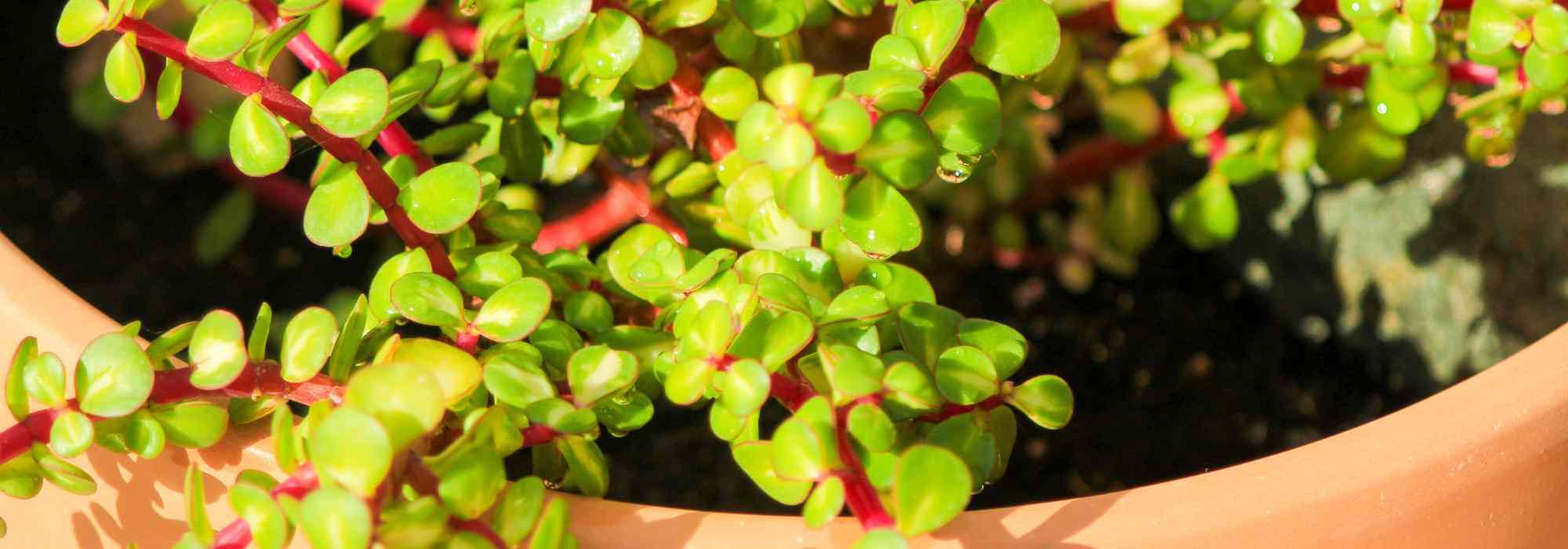
Portulacaria : cultivation, care, and varieties
Contents
The _Portulacaria afra_ in a few words
- This is an easy-to-grow succulent plant, perfect for indoors
- Its ramified and elegant habit gives it the appearance of a miniature tree
- Its foliage, resembling small coins, is highly decorative
- Low-maintenance, it thrives in well-drained substrates and prefers infrequent watering
- Whether solo in a pot, in a mineral composition, or as a bonsai, it adds an exotic touch
The word from our expert
The Portulacaria afra, also known as the elephant bush, is a succulent shrub with fleshy, glossy foliage, often confused with the jade plant (Crassula ovata). Native to southern Africa, it thrives naturally in dry climates but adapts perfectly to indoor life in our latitudes. Easy to care for and water-efficient, it has become a must-have among decorative succulent plants.
Highly prized for its green, coin-like foliage, sometimes variegated as in the Portulacaria afra ‘variegata’, this succulent charms with its ramified habit and miniature shrub-like silhouette. It prefers poor, well-draining substrates, infrequent watering, and bright indirect light.
In terms of maintenance, it requires little care and forgives missed waterings, maintaining a balanced appearance year-round. It’s ideal for beginner gardeners! It can spend the summer outdoors, provided it’s gradually acclimated. Shaping the Portulacaria into a bonsai is also possible, as it’s easy to train: it’s an excellent choice if you’re starting out in the art of bonsai.
Graphic and luminous, whether solo in a pot, integrated into a mineral composition, or styled as a miniature tree, the Portulacaria adapts to all décor styles.
Discover our collection of Portulacaria afra and fall for its easy cultivation, longevity, and timeless charm!
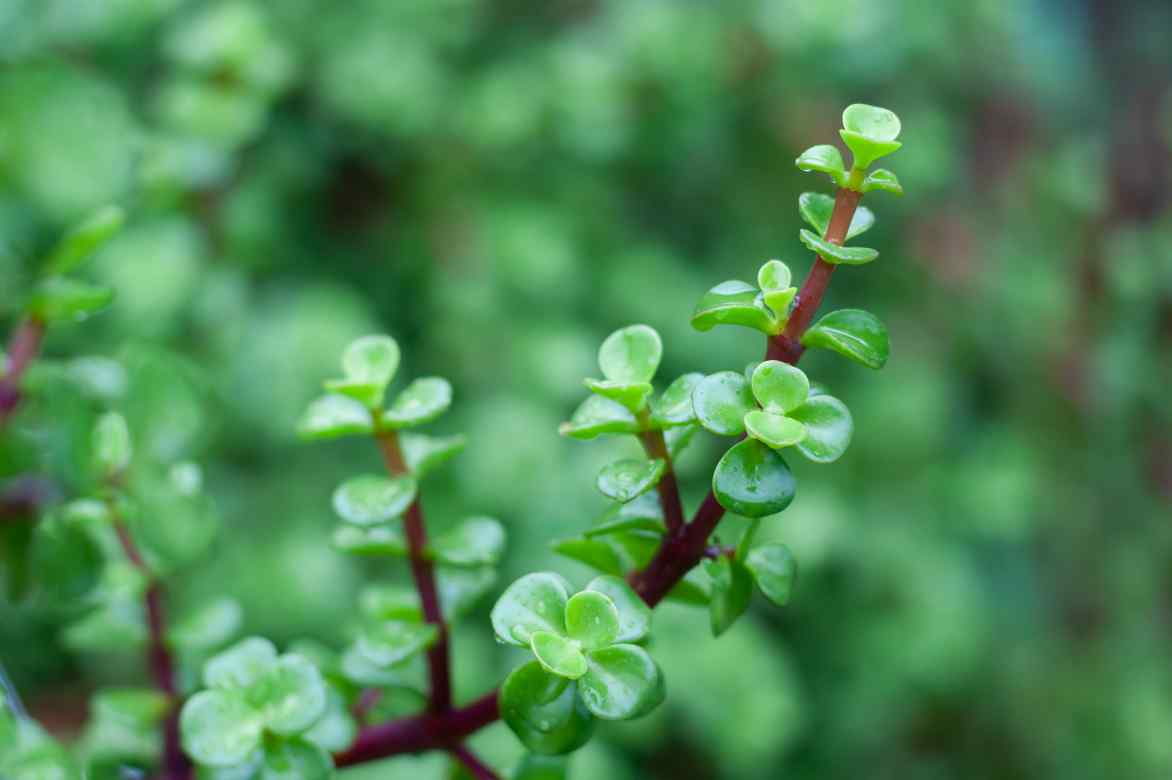
Close-up of the foliage of Portulacaria afra
Botany and description
Botanical data
- Latin name Portulacaria
- Family Didiereaceae
- Common name Elephant bush, Spekboom, Portulacaria bonsai, Money plant
- Flowering rare indoors
- Height between 50 cm and 1 m indoors
- Exposure indirect to bright light
- Soil type Light, well-draining and aerated substrate
- Hardiness Frost-sensitive
The Portulacaria belongs to the botanical family Didiereaceae or to the Portulacaceae family according to the old classification, two families that mainly include succulent plants native to arid environments. This shrub is a close relative of the genus Crassula, to the point of being frequently confused with the famous “jade tree” (Crassula ovata). This similarity is particularly evident in their fleshy leaves and their ability to store water.
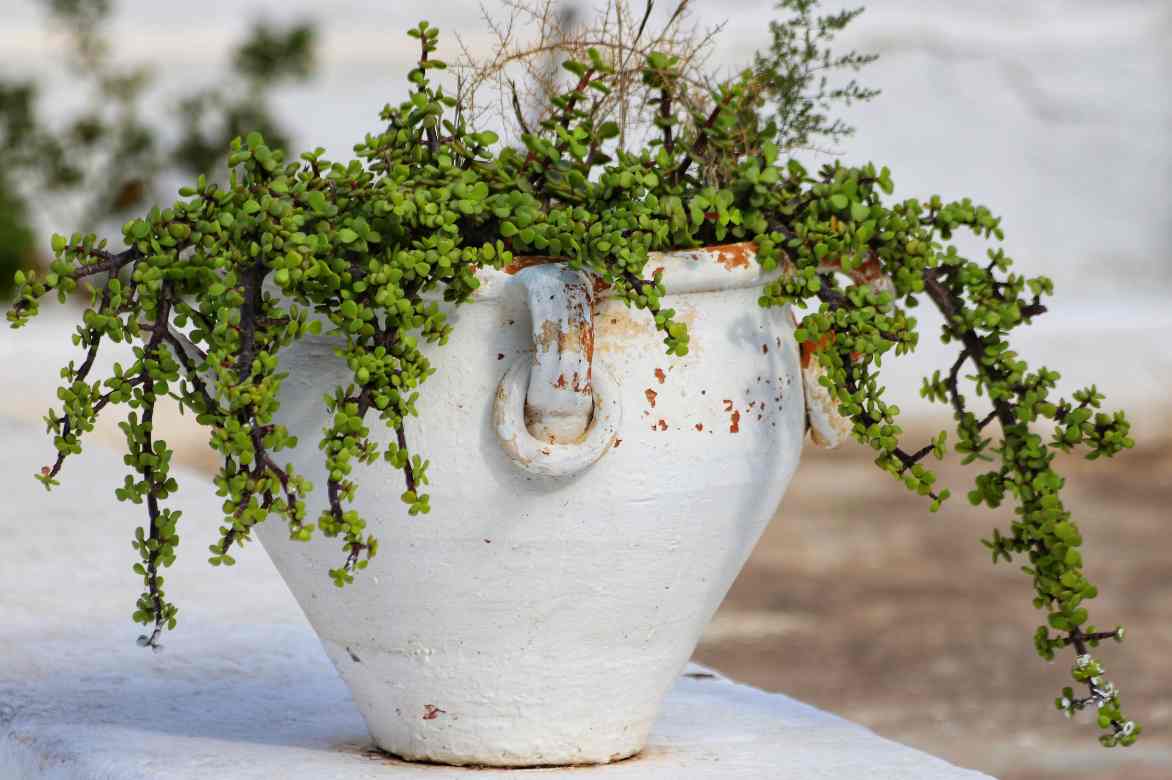
A slight resemblance to Crassula ovata, but its leaves are smaller
Portulacaria is best known under various evocative names such as “purple jade plant”, “bush purslane”, and “money plant”, popular names that reflect its ornamental appearance and its bushy habit, often confused, once again, with Crassula ovata.
In its natural habitat, it is found in Southern Africa, specifically in South Africa, where it grows in semi-desert environments, bathed in light, rooted in poor soils, perfectly suited to its succulent lifestyle. As plants of arid environments, Portulacaria have a CAM (Crassulacean Acid Metabolism) photosynthetic metabolism. This means they open their stomata at night to capture carbon dioxide, thus limiting water loss through evaporation during the hottest hours. This is a very efficient mechanism in dry climates, shared with other succulents.
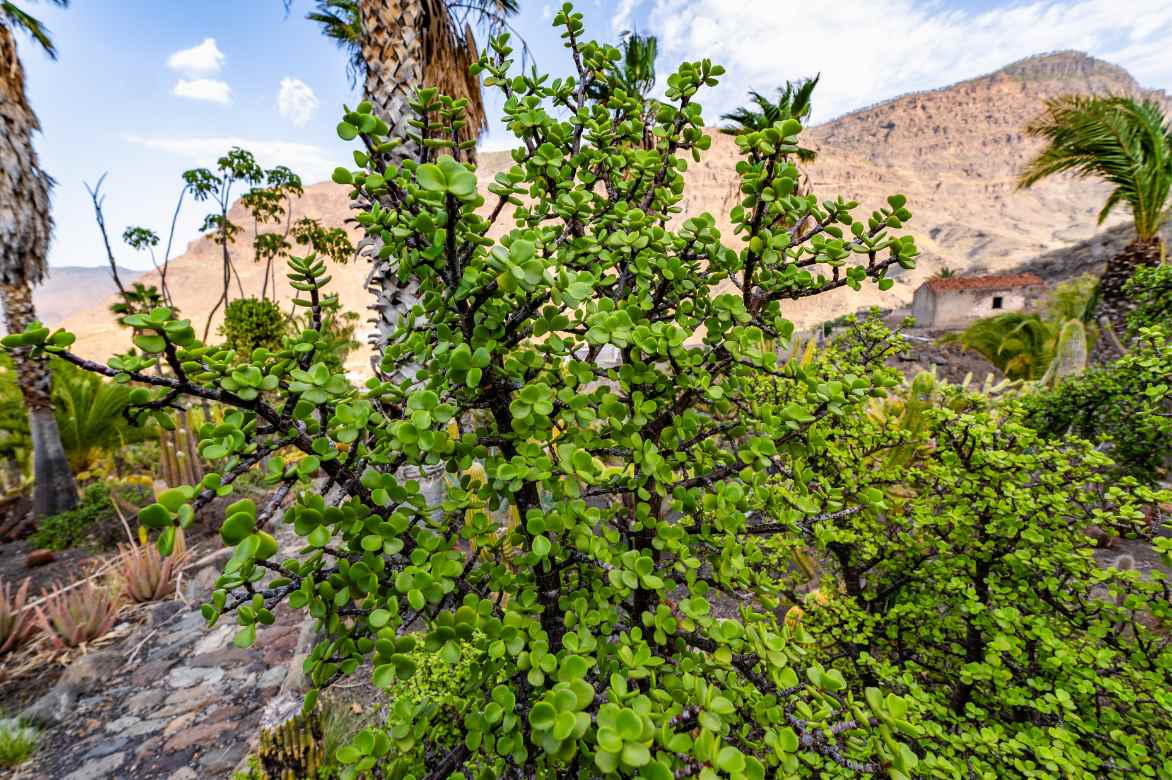
A Portulacaria afra in Africa, in its natural habitat
In our regions, it is mainly grown indoors or in a well-exposed conservatory, as it is frost-sensitive: it cannot tolerate freezing temperatures and begins to suffer as soon as the thermometer drops below 5 °C. But when grown under good conditions, Portulacaria can live for several decades, sometimes up to 50 years, making it as durable as it is decorative in our homes.
The genus Portulacaria, long considered monospecific, now includes seven recognised species, following recent taxonomic revisions that integrated several species formerly classified in the genus Ceraria. Among them, Portulacaria afra, sometimes called “little elephant tree”, remains by far the most cultivated and best-known. Among its main cultivars are ‘Variegata’ (Portulacaria afra var. ‘variegata’, a horticultural variety), with foliage variegated in green and cream, very bright, and ‘Prostrata’, a low-growing form distinguished by its creeping or decumbent habit, making it ideal for hanging baskets. The ‘macrophylla’ variety, on the other hand, is characterised by leaves twice as large as those of the type species.
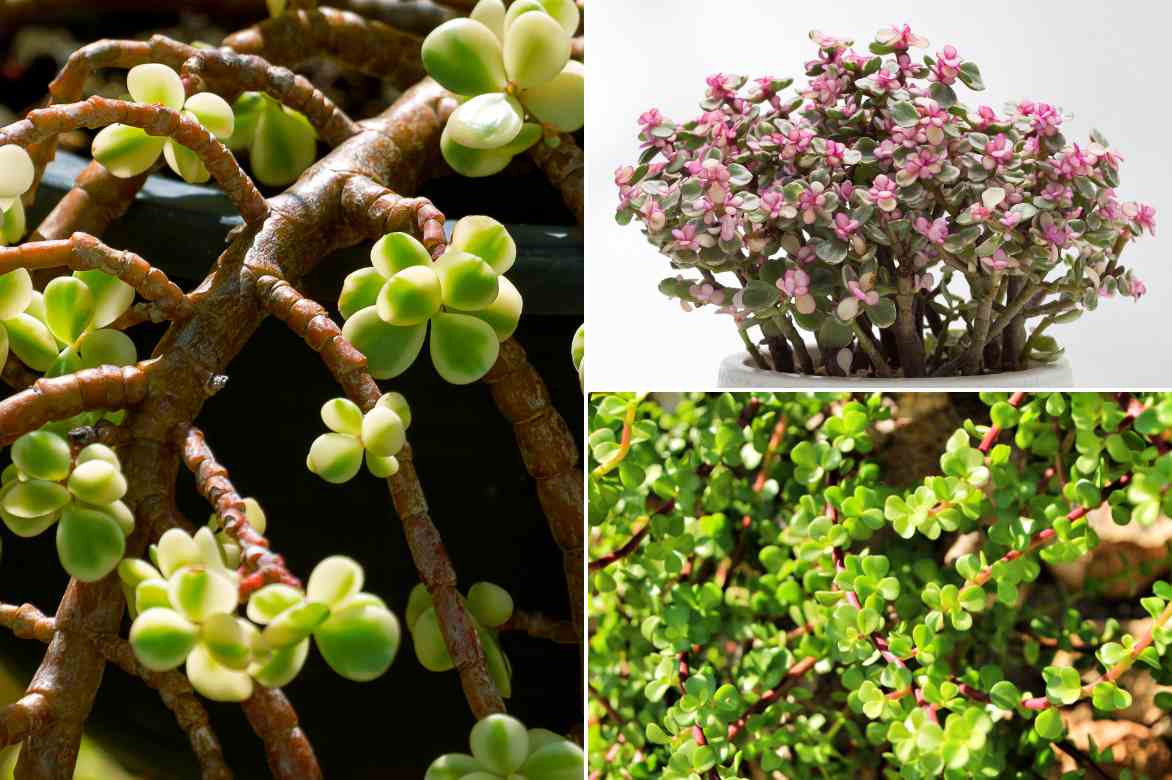
Portulacaria afra ‘Prostrata’. Top right, the variegated variety, and bottom right, the type species
Portulacaria naturally grows as a densely branched shrub, reaching 2 to 4 metres in height in the wild. In pot cultivation, its growth is slow, but it quickly forms a compact and well-structured silhouette. If it thrives, it can easily reach 1.5 metres in height. Its branched structure consists of initially soft and green stems, which gradually lignify to become reddish-brown. Its root system, shallow but well-spread, is perfectly adapted to well-draining soils and arid conditions.
Its evergreen foliage, emblematic of the genus, is dense, opposite, with no visible petiole, directly inserted onto the stems. The leaves are small, thick, fleshy, generally ovate to rounded, measuring 1 to 2 cm, quite similar to those of Crassula ovata, but usually finer and more flexible. Their surface is smooth, often shiny, capable of retaining water, with a colour ranging from jade green to dark green, depending on exposure and cultivar. Some variegated forms have a particularly bright cream to yellowish edge, while others turn red under strong sunlight.
Flowering, although rare in cultivation, is discreet and elegant. It mainly appears on mature and well-established specimens, under optimal light conditions, in the form of small star-shaped flowers with five petals, pale pink to mauve in colour, grouped in terminal inflorescences. In its natural habitat, flowering usually occurs in late summer or early autumn.
In some regions of South Africa, Portulacaria afra is used in ecological reforestation programmes, as it plays an important role in carbon retention and the restoration of degraded soils. It is also a food source for elephants, which contribute to its dissemination in the wild.
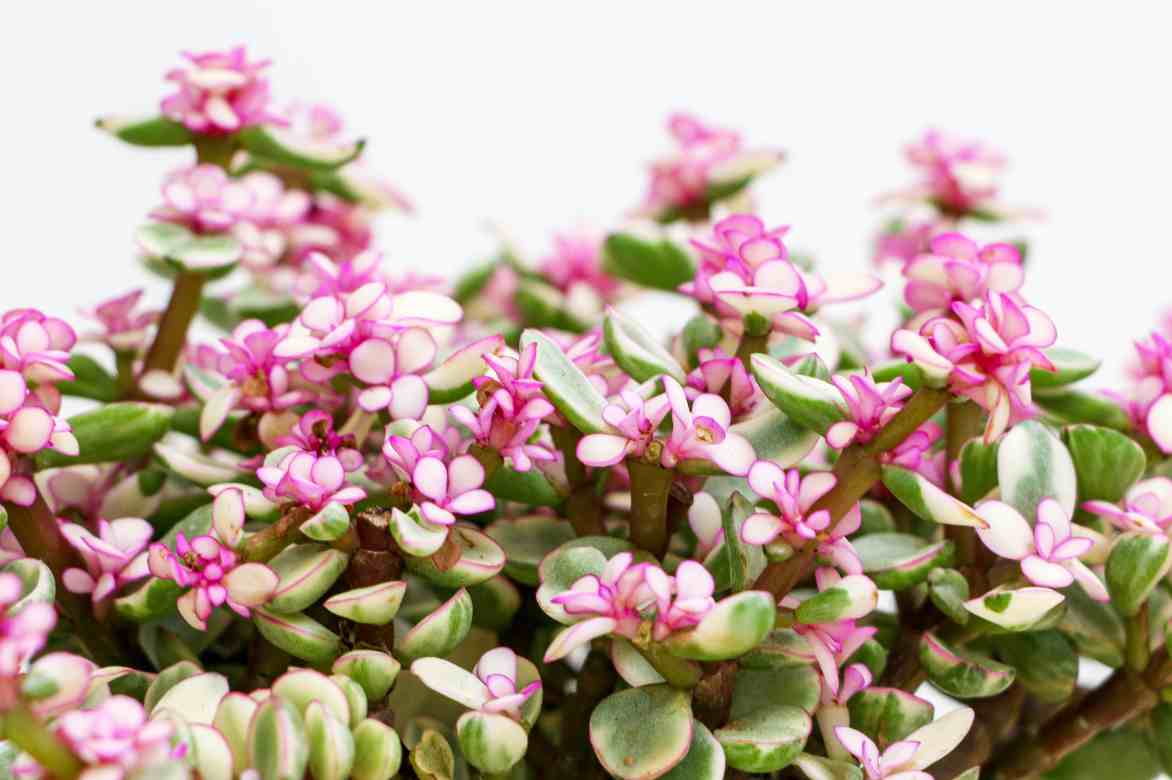
Flowering only occurs when the shrub lives in outdoor conditions
Read also
How to propagate Crassulas?Our varieties
Planting in Pots and Growing Conditions for Portulacaria Indoors
When to Plant Portulacaria afra in a Pot?
Portulacaria can be planted in a pot at any time of the year, provided temperatures are stable and there is sufficient light.
Where to Place the Pot?
Portulacaria afra is a non-hardy plant. Its hardiness is limited to around 10°C, meaning it cannot tolerate frost, even light frost. Below this temperature, its succulent tissues begin to suffer, and prolonged exposure to cold can cause irreversible damage or even kill the plant.
In Mediterranean regions (coastal areas, Corsica, etc.), it can be attempted in the ground, provided it is planted in perfectly drained soil, sheltered, and with winter protection (fleece, cold greenhouse, etc.), though this remains risky.
Indoors, Portulacaria thrives in bright, indirect light, while tolerating some gentle sun, especially in the morning or late afternoon. It will do well near an east or west-facing window, protected from harsh sunlight. It is an ideal plant for our heated interiors, as long as temperatures are kept between 18 and 25°C, with a minimum of 10°C in winter. Portulacaria can also be placed in a warm or temperate greenhouse, provided it receives good light and well-ventilated air without excess humidity. It prefers moderate ambient humidity, between 30 and 50%, which matches the conditions of most homes.
It also enjoys spending time outdoors during the warmer months: as soon as nighttime temperatures consistently exceed 12°C (usually from May to September), it can be moved to a balcony, terrace, or garden, gradually acclimating it to the light to avoid burns. It must be brought back indoors as soon as nighttime temperatures approach 10-12°C.

Reserve a sufficiently bright spot for your elephant bush
What Substrate to Use?
Portulacaria requires a perfectly draining substrate to avoid the risk of root rot. A special cactus and succulent mix is highly recommended. This type of substrate allows water to drain quickly and prevents stagnant moisture. You can also prepare an excellent homemade substrate by mixing:
- 1/2 light potting soil,
- 1/4 coarse sand (such as river sand),
- 1/4 perlite (or, alternatively, pumice or fine gravel).
How to Plant Portulacaria in a Pot: Step-by-Step
- Choose a pot with drainage holes, ideally made of terracotta to promote root respiration.
- Add a drainage layer (clay pebbles, gravel, or pottery shards) at the bottom of the pot.
- Fill with a cactus substrate, light and well-draining.
- Place the plant without burying the collar (the base of the stem) and gently firm the soil.
- Wait a few days before the first watering to allow the roots to adjust.
- Place the pot in a very bright spot, away from direct harsh sunlight.
Maintenance of Portulacaria Indoors
The Portulacaria is a low-maintenance plant, but a few simple steps ensure its longevity and beauty. Here’s how to care for a Portulacaria:
Watering the Portulacaria
The Portulacaria is a succulent that dislikes excessive moisture. It is essential to let the soil dry out completely between waterings. During the growth period (spring-summer), watering every two to three weeks may suffice, adjusting for heat and light levels. These plants tolerate drought perfectly and can go several weeks without water without suffering. In autumn and winter, it is best to significantly reduce watering, or even avoid it for several weeks if the room is cool and poorly lit.
Misting is unnecessary, as this plant tolerates dry indoor air very well. It does not appreciate its leaves staying wet for long periods. Fertiliser is absolutely not essential.
Pruning the Portulacaria: Why and How to Do It?
Pruning is optional but can be useful to maintain a balanced shape, limit height in pots, or encourage branching for a denser habit. It is best done in spring, around May. This coincides with the resumption of growth, which aids healing and recovery. Lighter pruning can, however, be done year-round. As with Crassula, it is preferable to do it by hand, breaking the stems at a node. Healing is then quicker and often cleaner than after a sharp cut.
Offshoots at the base of the trunk frequently appear: they can be removed to maintain a single-trunk form, unless you wish to grow the plant with multiple trunks. The Portulacaria tolerates severe pruning very well: an overgrown plant can be drastically shortened and will regrow without difficulty. It responds well to pruning and can even be trained as a bonsai.
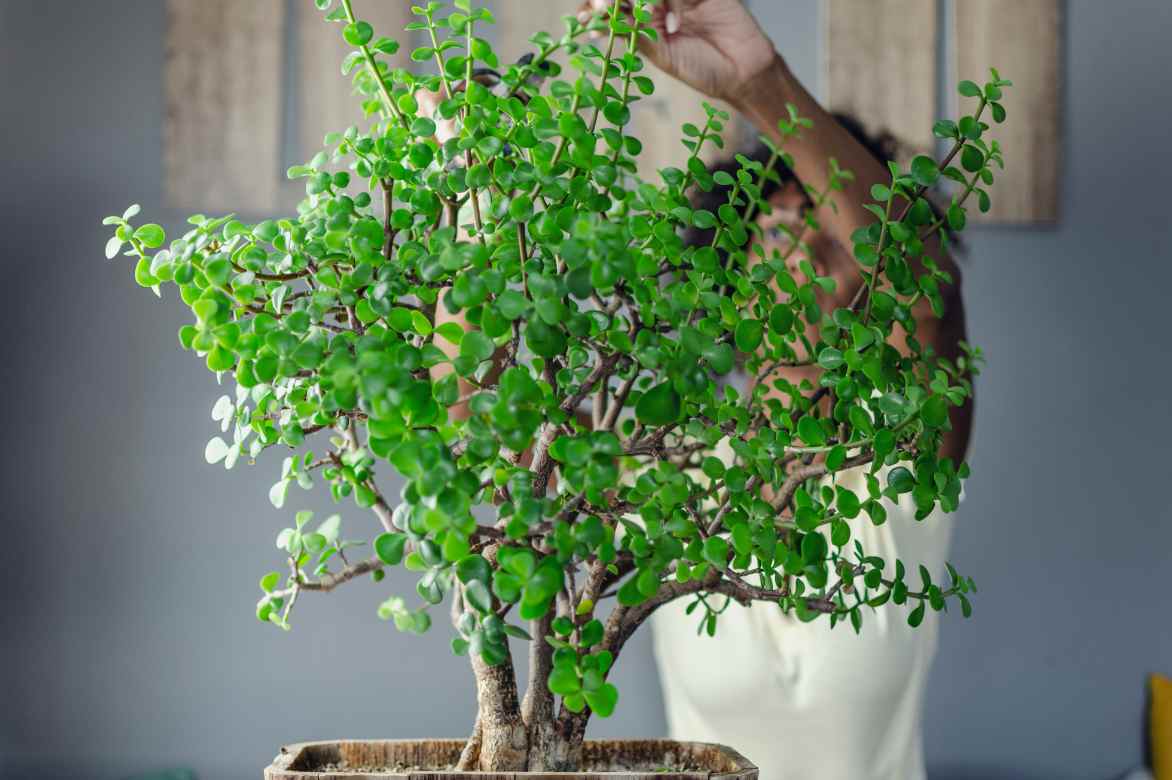
Although optional, pruning can be done if your plant takes up too much space indoors
When and How to Repot a Portulacaria?
Repotting should be done every two to three years, preferably in spring, when the plant seems cramped or the soil becomes compact. Choose a pot slightly larger than the previous one, always with good drainage. During repotting, you can lightly refresh the roots (removing damaged ones) and completely renew the soil. Wait at least 15 days before watering it.
Parasites and Diseases of Portulacaria: How to Avoid Them Indoors?
The Portulacaria is generally a robust plant and rarely prone to diseases, especially when kept indoors. However, certain cultivation mistakes or unfavourable conditions can encourage the appearance of parasitic issues or symptoms related to environmental stress.
Possible Parasites of Portulacaria Indoors
The Portulacaria is rarely affected by parasites, but it may occasionally attract scale insects or aphids.
Find all our tips to identify and eliminate them naturally:
- →Aphids: Identification and Treatment and How to Get Rid of Aphids on Indoor Plants?
- →Scale Insects: Identification and Treatment
Common Diseases of Portulacaria: Signs and Precautions
The diseases observed in Portulacaria are almost always linked to excess moisture or poor placement:
- Root Rot: Caused by poorly drained soil or overwatering. The leaves soften, the stem may blacken at the base, and the plant deteriorates rapidly. Repot urgently in dry, well-drained soil after removing affected parts.
- Wilting: Often due to overwatering, even if the soil appears dry on the surface. Always check moisture levels deep in the soil before watering.
- Etiolation: Manifests as long, thin stems with exaggerated spacing between leaves. This is a clear sign of insufficient light. Move the plant to a brighter location, ideally near a well-exposed window.
Precautions to Take:
- Never allow water to stagnate in the saucer.
- Use very well-draining soil and a pot with drainage holes.
- Always let the soil dry out completely between waterings.
- Provide bright indirect light, or even a little gentle sunlight.
- Avoid sudden temperature changes and cold drafts.
How to take cuttings of Portulacaria afra?
The Portulacaria is very well suited to propagation, even for beginner gardeners. To maximise the chances of success, it is advisable to take cuttings in spring or summer, when the plant is in full growth. Heat and light promote quick and healthy rooting. Propagation by sowing is possible, but stem or leaf cuttings are the most reliable techniques.
Stem cuttings:
- Take a healthy and vigorous stem about 8 to 10 cm long, at a node, with several leaves.
- Allow the cutting to dry in the open air (but not in direct sunlight!) for 2 to 5 days.
- Plant the cutting in a small pot filled with dry, well-draining cactus substrate.
- Do not water immediately: wait about 5 days before giving a light first watering (watering immediately on a fresh wound, even if planted, increases the risk of rot).
- Place in bright light, at 20°C, without direct sunlight.
- Afterwards, keep the substrate slightly moist but never waterlogged.
- Roots will appear in 2 to 3 weeks.
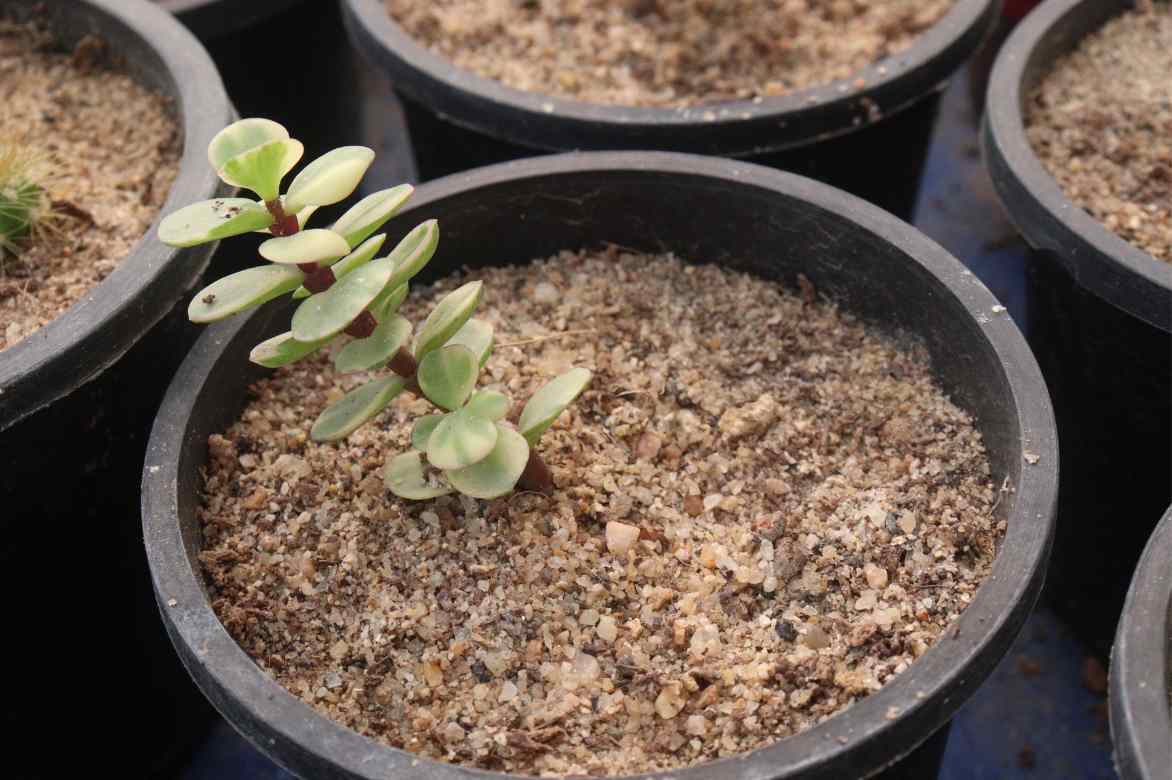
Propagate in an ultra-draining substrate
Leaf cuttings (slower but possible):
- Gently detach a healthy leaf.
- Allow the base to dry for a few days to prevent rot.
- Simply place the leaf on the surface of a dry, well-draining substrate without pressing it in.
- Maintain bright light, without direct sunlight, and a slightly humid environment.
- With patience, a young shoot may appear at the base of the leaf.
How to incorporate Portulacaria into your indoor décor?
With its structured habit, dense and luminous foliage, and the appearance of a small exotic bush, the Portulacaria is a graphic plant that fits perfectly into many interiors. It adds a touch of structured greenery.
It naturally finds its place in the bright spaces of the home: a living room where it catches the eye, a bright kitchen where it adds a touch of greenery without cluttering (it works very well paired with herbs, for a green corner that is both useful and decorative), or even a sunlit bedroom, which it dresses in its soothing green. In a conservatory or winter garden, it becomes a true ornamental bush, showcased in a large pot to highlight its elegant lines.
To create a more mineral ambiance, it can be paired with other succulent plants like Echeverias, Aeoniums, Haworthia, Aloe, Sedum, or even globular cacti like the Mammillaria. Grouped in a minimalist composition, adorned with pebbles, gravel, or light sand, these companions evoke the arid landscapes of southern Africa, its native habitat.
Finally, for enthusiasts of artistic forms, the Portulacaria lends itself wonderfully to bonsai cultivation. Easy to shape, responsive to pruning, and naturally ramified, it allows for the creation of small zen plant scenes, full of character and serenity.
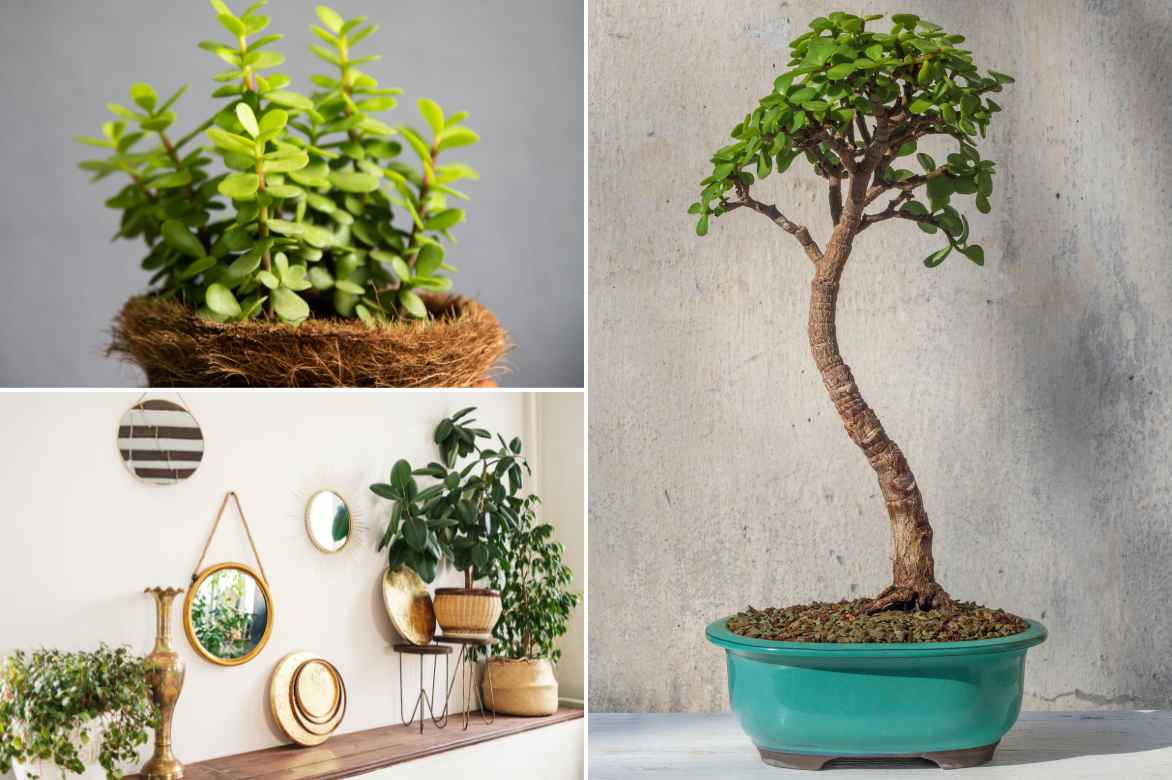
The Portulacaria blends into many decorations
Also worth reading
→ Discover our other succulents and cacti!
→ Discover our wide range of houseplants.
→ Our decorative foliage houseplants and our flowering houseplants.
→ Our numerous books on houseplants, such as The Encyclopaedia of Houseplants by Solène Moutardier, published by Ulmer.
Frequently asked questions
-
Why is my Portulacaria losing its leaves?
Leaf drop is often caused by excess water, especially if the soil remains permanently damp. A lack of light, a cold draught, or thermal shock can also be the reason. Sometimes, the plant simply reacts to a change in location or temporary stress. Make sure to let the soil dry out between waterings and place the plant in a bright spot, sheltered from sudden temperature changes.
- Subscribe!
- Contents
































Comments